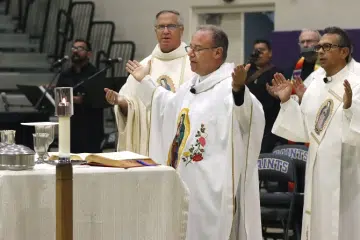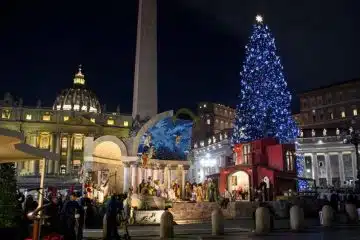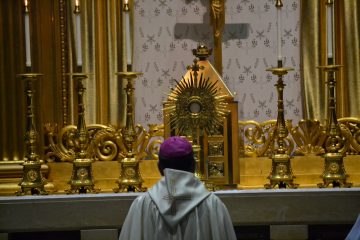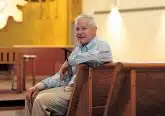An Offering in Wood: Portrait of Devoted Craftsmanship

 Woodworking has run through the Otmar family line for more than five generations. For Josef Otmar V, however, the craft became more than a trade—it is a vocation, one that serves the Church by creating sacred spaces for Eucharistic worship.
Woodworking has run through the Otmar family line for more than five generations. For Josef Otmar V, however, the craft became more than a trade—it is a vocation, one that serves the Church by creating sacred spaces for Eucharistic worship.
Otmar’s journey into woodworking began early, when he entered an art contest at just 11 years old, crafting a piece out of veneer that won first prize. A few years later, while studying at Moeller High School, he sculpted a figure of Christ holding up the world, symbolizing unity among the races. That piece still hangs in his home, a daily reminder that faith has always guided his art.
“As with many things we do liturgically, it starts out as one thing, and it just becomes something God wants it to become,” reflected Otmar. “It’s out of our control.”
He grew up with a deep appreciation for the Catholic faith and his family’s sacrifices. His father, once a slave laborer during World War II, escaped both Nazis and Communists before beginning anew in the West. That resilience, Otmar believes, shaped his own commitment to using his gifts for more than wealth or acclaim: for service.
“I’ve never wanted to get rich,” said Otmar. “I just want to get along, to not be a burden—and to give my talents back to the Church.”
Over the decades, his hand-carved works have found homes in parishes across the Archdiocese of Cincinnati and beyond. Each piece is prayerfully designed and constructed with precision, from altars and sculptures to baptismal fonts and crosiers. Among his most meaningful creations are tabernacles and monstrance cabinets—sacred vessels holding and displaying the heart of Catholic life: the Real Presence of Christ.
“When you see that monstrance cabinet lit up with the Eucharist inside, it’s absolutely glorious,” said Otmar. To make that moment even more radiant, he sometimes sprinkles fine silver powder behind the background so the light shimmers around the Blessed Sacrament. “It’s as if we are giving it the kind of reverence of holiness it deserves.”
For Otmar, this work is inseparable from his own spiritual life. “When I do liturgical work, it calls me to a higher standard, a deeper faith,” he explained. “The Eucharist is what sets us apart as Catholics. Creating these sacred spaces inspires me to embrace my faith more closely.”
That connection between craft and faith makes Otmar’s work a true vocation. He shares his time, talent, and skill by guiding the faithful to encounter Christ in the Eucharist.
“I pray a lot before I design,” Otmar said. “I ask the Holy Spirit to guide my hand.” Often, he sees God’s providence in the smallest details—a client offering a piece of wood that later becomes the perfect carving, or a chance encounter leading to a new commission. “People call it luck or coincidence. I call it God’s invisible hand in our lives.”
Otmar is currently working on furnishings for the Roger Bacon High School chapel. Like every project before it, he sees it as an opportunity to promote deeper Eucharistic devotion. Looking ahead, his dream is simple but profound: to see more parishes create a space that elevates adoration of the Blessed Sacrament.
“If I could, I’d build a monstrance cabinet for every church in the archdiocese,” said Otmar.
To Otmar, woodworking is not merely a craft passed down through generations. It is a vocation— an offering of skill, prayer, and love that helps the faithful encounter the mystery at the heart of Catholic life: Christ present in the Eucharist. ✣
This article appeared in the November 2025 edition of The Catholic Telegraph Magazine. For your complimentary subscription, click here.













